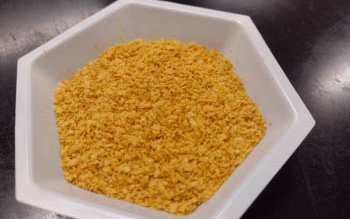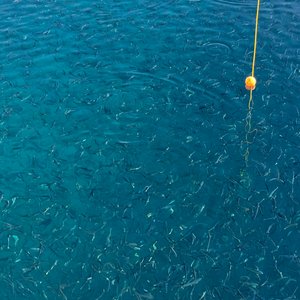Researchers with UC Santa Cruz’s ecological aquaculture facility have developed a new life cycle sustainability assessment documenting the environmental benefits and impacts of using the marine microalgae Schizochytrium sp. as an alternative aquaculture feed ingredient to replace fish oil sourced from wild-caught forage fish.
The study found that Schizochytrium sp. could be a more sustainable feed ingredient than fish oil in categories like global warming impact and use of biotic resources from living organisms. However, there were comparatively greater environmental impacts in other areas—like freshwater use, land use, and nutrient pollution potential in oceans and freshwater—primarily due to steps in the production process for the microalga that are linked to land-based agriculture. Researchers say that identifying these types of tradeoffs is crucial in weighing the benefits of Schizochytrium sp. as an aquaculture fish feed ingredient.
UC Santa Cruz researchers have been experimenting with Schizochytrium sp. to formulate new high-performing fish-free feed options and wanted to better understand the overall sustainability of Schizochytrium sp. by taking a look at its entire production process. They worked to expand scientific and publicly available information on the topic by conducting a comprehensive life cycle sustainability assessment that reflects current industry best practices and is replicable and shareable in an open-access format.
“This study could be useful for microalgae production companies and aquafeed manufacturers in understanding what the environmental impacts of this feed ingredient are and also guiding efforts to make targeted improvements in its production,” said Brandi McKuin, a postdoctoral researcher at UC Santa Cruz and lead author of the new study. “Overall, I think our findings are a hopeful message that microalgae can be a sustainable ingredient, and with a little more work across the supply chain, it could become even more so.”
The study
The research team specifically focused on comparing the sustainability of fish oil versus a blend of Schizochytrium sp. and canola oil to replace both the DHA omega-3 fatty acids and lipid content of fish oil. These two feed ingredient options were analyzed across six sustainability categories: global warming potential, water consumption, land use, marine eutrophication potential, freshwater eutrophication potential, and biotic resource use.
Researchers used data from published literature and patents to model the sustainability impacts of both ingredient options, and then they ground-truthed their assumptions with volunteer industry advisors. The study also considered several different methods of preparing Schizochytrium sp. for inclusion in fish feeds, since it can either be used as whole cells or processed into oils using microwave or solvent extraction techniques.
Feed ingredients formulated using Schizochytrium sp. had less impact than fish oil on biotic resource depletion across all forms of preparation, while the whole-cell method, in particular, had significantly lower global warming potential than fish oil, due to lesser processing than methods for extracting oils from Schizochytrium sp. But between the two oil extraction methods, conventional solvent extraction had significantly lower environmental impacts than microwave extraction in all categories except global warming potential.
High impacts related with sugar production
Schizochytrium sp. had higher environmental impacts than fish oil on freshwater consumption, land use, marine eutrophication potential, and freshwater eutrophication potential, in large part because Schizochytrium sp. must be fed sugars while it’s being grown commercially. Those sugars come from land-based agriculture sources. The study analyzed two sources in particular: sugarcane grown in Brazil, and sugar beets grown in the United States.
Researchers say that their results, showing the large impact of the cultivation process for these sugars on the overall sustainability of Schizochytrium sp., may be an opportunity. “Companies might be able to use these results to encourage increased sustainability in how these sugar crops are being grown,” said Environmental Studies Professor Anne Kapuscinski. “If there are ways to produce these crops that use less water, are land-sparing, or use less fertilizer or use organic fertilizers, this study might help open the door to have those kinds of conversations.”
Overall, the study illustrates how replacing ocean-derived fish oil with alternative aquaculture feed ingredients can shift the environmental burden from sea to land. However, the research team says that prioritizing among these types of trade-offs is a complex decision-making process. Each benefit and impact must be weighed within global and regional contexts.
“Every choice has some kind of environmental impact, so you’re always going to find trade-offs in a life cycle assessment,” Kapuscinski said. “There is no one silver bullet, but laying out estimates like these of what the impacts are, based on the best scientific evidence available, can really help with informed decision making in sustainability efforts.”
Check out the study here.













